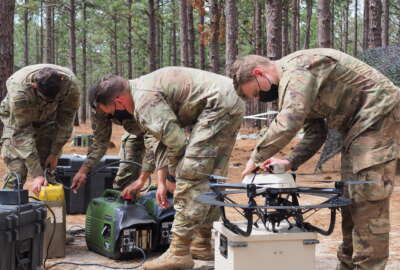Army attempt to modernize IT for multi-domain ops is establishing milestones, filling in top leaders
The Army says it is establishing concrete methods at top levels to move plans forward with an IT modernization that will create the network needed for joint...
BALTIMORE — The Army says it is establishing concrete methods at top levels to move plans forward with an IT modernization that will create the network needed for joint operations in the future.
The service is working on the governance of its Unified Network, it is also directing personnel to important areas of the program and establishing milestones to do a final push on the barrier between strategic and tactical networks.
“Last week, we briefed the undersecretary of the Army on that approach and he has endorsed it and, quite frankly, is building it into his day-to day-governance,” Lt. Gen. John Morrison, deputy chief of staff for the Army, Tuesday at the AFCEA TechNet Cyber conference. “We are well on our way in execution. We will guide it through the Army’s orders process, so that we can align resources and people in organizations and establish accountability.”
Federal News Network reported last year that the Army will start implementing concepts that are meant to unify its enterprise and tactical networks in 2022, these newest actions are some of the first steps in doing that.
The Army has been working on the Unified Network since October 2021, when it released a strategic plan for the program.
The Army’s Unified Network plan has five lines of effort it says are critical to shaping the future of the Army. That include establishing the network to enable multi-domain operations, posturing the force for those multi-domain operations, and sustaining the network.
The other two lines of effort include reforming processes and policies and securing freedom of action in cyberspace.
The Army wants to have a multi-domain operational force by 2028.
The strategy highlights a three-phased plan, the first of which ends in 2024. That phase will establish a security architecture built on zero-trust principles, synchronization with 5G and move capabilities to the cloud.
The other phases move out to 2028 and focus on completing the Defense Department Information Network Ops structure and then implementing the Unified Network for things like robust computers, edge sensors, robotics and cybersecurity.
Senior leaders are planning to finalize a new Army Network Plan in the next several months. That document will help to define what the common network architecture will look like in which the Unified Network will operate.
Also yet to be determined is how the plan for a unified network will play into the service’s plan to largely outsource day-to-day network operations on its garrisons. The Army is still piloting the Enterprise-IT-as-a-Service (EITaaS) approach on three of its installations, and doesn’t expect to make any final decisions on the way ahead for the rest of its bases until 2023.
“We’re working through all of that, but the notion of the unified network merely would fit under that [EITaas] umbrella, or it would be a component of how we provide the unified network,” Morrison said last year. “The hope is we can be more effective and efficient by working with our industry partners, but the notion of the unified network in support of multi-domain operations is they have to be mutually supporting.”
The military in general is putting a huge emphasis on multi-domain efforts. One of its current flagship programs is Joint All Domain Command and Control.
That concept will bring together many different weapons and systems throughout domains so decision makers can see and share data quickly to take fast action.
Copyright © 2025 Federal News Network. All rights reserved. This website is not intended for users located within the European Economic Area.
Scott Maucione is a defense reporter for Federal News Network and reports on human capital, workforce and the Defense Department at-large.
Follow @smaucioneWFED






